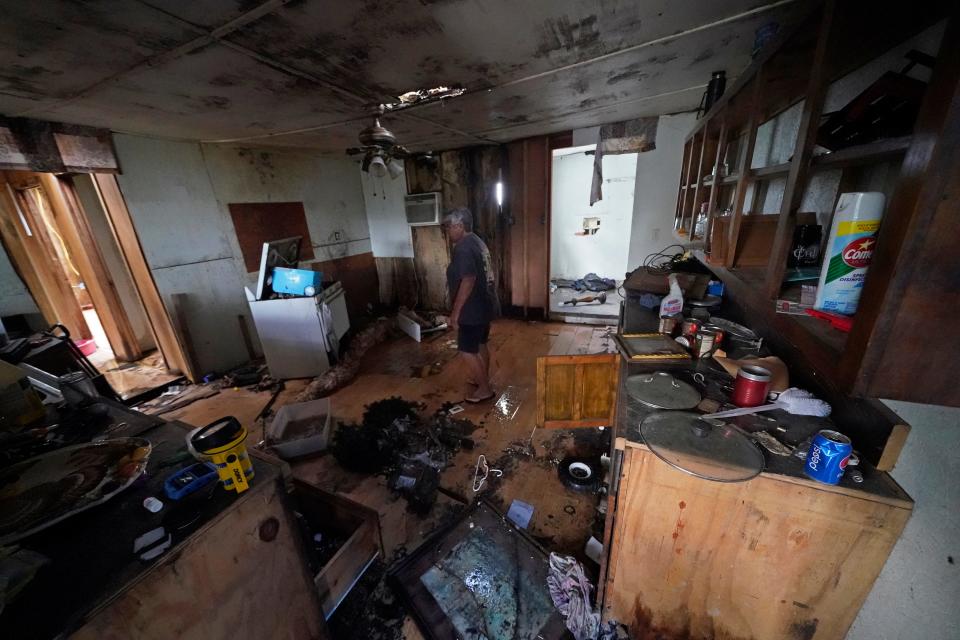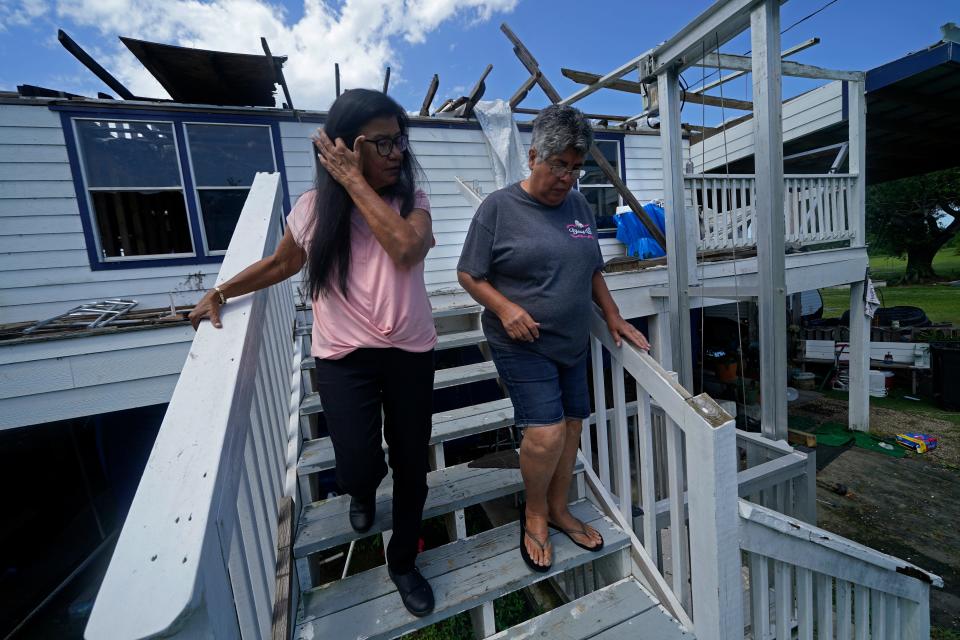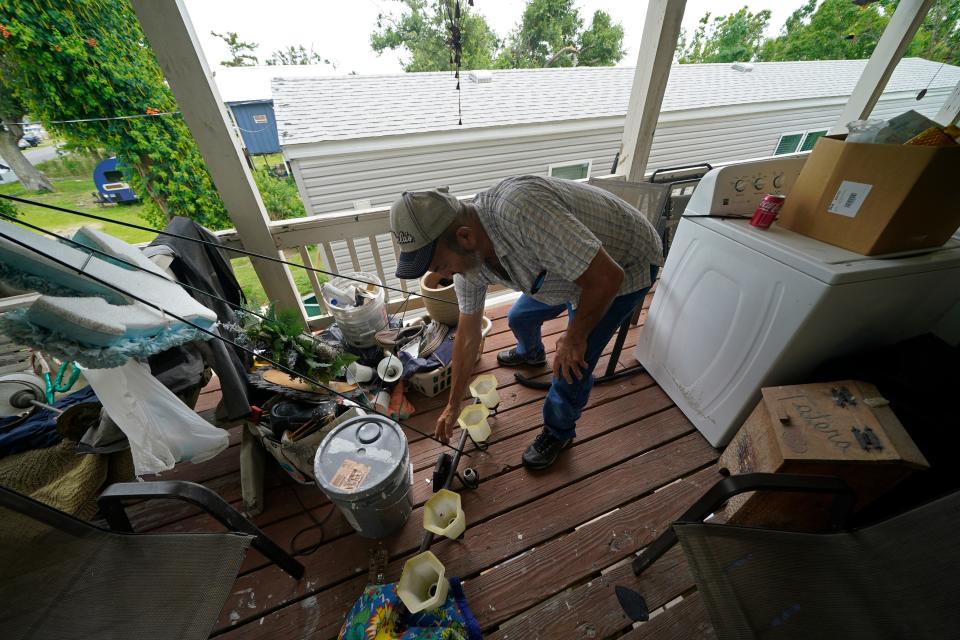Terrebonne's Native Americans mull future of home and culture after Ida's destruction
Driving through her village in southeastern Terrebonne Parish, tribal official Cherie Matherne points out remnants of house after house — including her own — wrecked nearly 10 months ago when Hurricane Ida roared through the Pointe-au-Chien Indian Tribe community.
Trailers from the Federal Emergency Management Agency and travel campers sit next to pilings that elevated homes 14 feet off the ground to protect them from flooding. But the wind got them this time. For hours, the Category 4 hurricane tore off roofs and siding, ripped out insulation and scattered treasured belongings.
"It's going to take years before people can get back to their lives. The majority of people are still at a standstill," said Matherne, the tribe's cultural heritage and resiliency coordinator.
When Ida barreled through southeast Louisiana on Aug. 29, it slammed into an area home to many Native American tribes, battering people already struggling to overcome decades of coastal erosion and the long shadow of discrimination. With the start of a new hurricane season predicted to be as busy as the last, tribal officials worry their people could be in the crosshairs again.
"Ida was the worst storm we've ever had in our area," said August Creppel, chief of the United Houma Nation. The tribe's roughly 19,000 members are spread across coastal Louisiana, about 11,000 of whom experienced some sort of damage from Ida, according to Creppel.
"Some of our people don't even have a house to go back to," he said.
'We're still hurting': Houma area tourism struggles to recover after COVID, Hurricane Ida
Other tribes also were hammered. Pointe-au-Chien Indian Tribe member Theresa Dardar said only about a dozen homes in the lower part of the Pointe-aux-Chenes community survived the storm.
Farther west, where many members of the Grand Caillou/Dulac Band of Biloxi-Chitimacha-Choctaw live, Chief Shirell Parfait-Dardar said everyone had some sort of damage, with about 20% of homes a total loss, even her own.
Native Americans lived in southeast Louisiana's bayou regions since long before French explorer Rene-Robert Cavelier reached the mouth of the Mississippi River in 1682. Historically, they have been intimately tied to the land and water there. Many make their living shrimping or crabbing in the marshes and estuaries; their parents and grandparents trapped muskrats or nutria.
Eroding land, eroding culture

But decades of development have eroded that land from under them. Levees built to prevent the Mississippi River from flooding have starved coastal Louisiana of the fresh sediment it needs to rebuild land; canals dug to facilitate oil and gas development or shipping have allowed saltwater to encroach farther inland.
That means the buffers of land, trees and marsh grass that once protected Native American communities from storms in the Gulf have dwindled even as climate change portends a future of stronger, wetter storms.
Lester Naquin's father, a trapper, used to take his son crabbing and shrimping. Naquin remembers when there was so much land that his family raised cattle behind his house in Pointe-aux-Chenes. Now, he said, if you go past the levee to fish, you'll catch speckled trout, a saltwater species.
'It just escalates': After Ida, pandemic, crime remains top concern in Houma-Thibodaux
The 70-year-old Naquin loves the bayou. That's why he decided to come back even after Ida destroyed the home he used to share with his extended family. With FEMA money and materials and contractors paid for by a charity, he's been one of the few to rebuild in the region.
He's still living in a FEMA-supplied trailer while the house is finished, but it's lonely for a man who used to live with multiple generations. And he's not sure how many of his family will return. The shell of his nephew's home still stands next door. But this is where Naquin grew up, where his memories are.
"As long as I can stay down here, I will," he said.
'We're an adapting people'

Decades of discrimination against Native people reverberate today in ways that affect their ability to prepare and recover from hurricanes, tribal officials say.
Discrimination restricted where they could go to school, and when they were allowed to go to school, many faced harassment. Louise Billiot, a tribal official with the United Houma Nation who helps people get job training, said she can see the ripple effects of that lack of education among tribal elders who have difficulty using computers or cellphones to file hurricane claims or track their appeals.
The tribes most affected by Ida did not have federal recognition, although they're in a decades-long process seeking it. Tribal officials say federal recognition would give them better access to funding for more hurricane-resistant homes and programs to help improve members' lives ahead of storms.
More: Temporary housing for some Hurricane Ida victims may soon end. Residents mull next steps.
After storms, federal recognition would let them work directly with the federal government, tribal officials say. When the Seminole Tribe of Florida was hit by Hurricane Irma in 2017, the federally recognized tribe requested and received an emergency declaration from then-President Donald Trump to help address their needs.
Parfait-Dardar said the Grand Caillou/Dulac Band of Biloxi-Chitimacha-Choctaw is looking at ways residents can rebuild homes stronger than before. "We're an adapting people, always have been," she said. But she worries that tribal members who cannot afford to rebuild will be forced to move.
Will they rebuild?

Rebuilding also can be an exhausting process, especially for older tribal members.
Irene Verdin, 67, a member of the United Houma Nation who lives in the Pointe-aux-Chenes area, is living in a FEMA trailer next to the remains of her house, where mementos still lie on the floor. Her roof is long gone — somewhere in the marshes behind her house.
She is the main caretaker for her sister-in-law, who has had two strokes. And Verdin's 73-year-old husband, who used to work on boats, had a heart attack this year. Since the storm, her own blood pressure is climbing.
More: Houma musicians staging a comeback after COVID pandemic and Hurricane Ida
Deciding what to do is almost paralyzing. She'd like to rebuild, but just getting an estimate from a contractor is difficult — let alone finding a way to pay for construction. Verdin said she sometimes feels like those living down the bayou are forgotten.
"It's still up in the air in my head. It's still up in the air as to what we're going to do," she said. "It's hard."
This article originally appeared on The Courier: For Louisiana Native American tribes, Ida recovery an uphill fight

